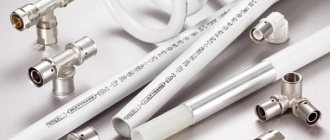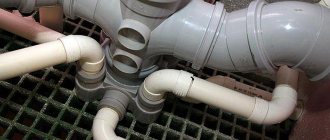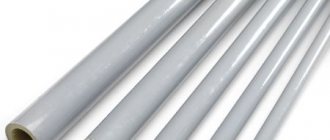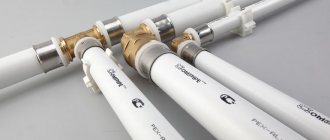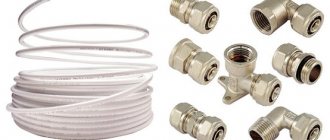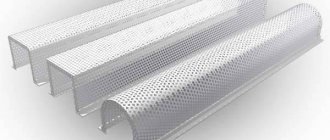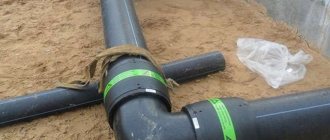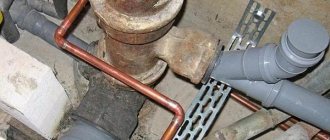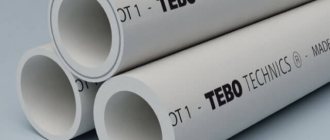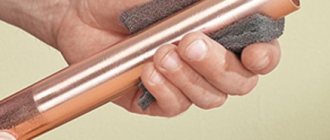There is no such thing as too many construction tools. Anyone who repairs professionally or as an amateur will agree with this statement. Most operations can be performed manually using a minimum of tools, but is there any point in this?
Any job is easier to handle if you choose the right equipment. And a pipe cutter for metal-plastic pipes is no exception - it is inexpensive, but significantly speeds up the process of laying pipes. But how to choose the right equipment and not get confused in the range of tools on the market?
We will examine these questions in our article, looking at the main types of pipe cutters and the best offers on the market, their features and characteristics. We will also talk about the intricacies of choosing suitable equipment and discuss the rules for cutting pipes at home.
Advantages of manual and electric pipe cutters
Tools for cutting metal-plastic pipes can be of 2 types:
- manual;
- electric.
A manual pipe cutter works due to the muscular strength of the person using it. It can be used in any conditions, there is no connection to the availability of power, there are no restrictions on operating time depending on the battery capacity and there are no other inconveniences associated with using a power tool.
However, no one will argue that for large volumes of work, hand tools may not be enough. This is especially true for thick-walled, large-diameter metal-plastic pipes. Of course, such materials are rare in household construction, but for a professional plumber this is a very real situation.
The tool saves employee time and effort. In addition, the human factor is excluded when it “didn’t press”, “didn’t check” or the eye failed
An electric pipe cutter with a battery is a real salvation when cutting on an industrial scale. In the case of a power tool, a person only makes a mark where the cut is to be made, then secures the part so that the mark on the pipe and in the pipe cutter window coincide as accurately as possible, then turns on the power and gets a neat, perfectly even cut.
Of course, it's not just about convenience. The cost of a cordless pipe cutter for metal-plastic pipes is several times higher than the cost of a hand tool. No one wants to overpay, unless, of course, you use the device in professional activities almost every day.
How to connect and install metal-plastic pipes
Steel pipes are gradually being forced out of the market: worthy competitors have appeared that cost less, are easier to install, and serve no less. For example, hot and cold water supply and heating systems are made from metal-plastic. How to properly install metal-plastic pipes, what fittings to use when, how to use them to connect sections into a single whole - all this will be discussed.
Types of fittings for metal-plastic pipes
The structure of metal-plastic pipes is such that it is impossible to weld or solder them. Therefore, all branches and some bends are made using fittings - special elements of different configurations - tees, adapters, angles, etc. With their help, a system of any configuration can be assembled. The disadvantage of this technology is the high cost of fittings and the time that will have to be spent on their installation.
An approximate range of fittings for installing metal-plastic pipes with a press
The advantage of metal-plastic pipes is that they bend well. This allows you to use fewer fittings (they are expensive).
Deciding what type of fittings to use is easy. Crimping ones are used for pipelines that are always accessible - connections need to be tightened over time. Pressed ones can be walled up. That's the whole choice - you need to know what type of installation of metal-plastic pipes will be in a specific area.
Appearance of some fittings with union nuts - screw or crimp
A common disadvantage of metal-plastic pipes is that due to the design of the fittings at each connection, the cross-section of the pipeline becomes narrower. If there are few connections and the route is not long, this cannot have any consequences. Otherwise, either an increase in the cross-section of the pipeline or a pump with more power is necessary.
Preparation for installation
First of all, you need to draw the entire plumbing or heating system on a piece of paper. At all branch locations, draw the fitting that needs to be installed and label it. This makes it convenient to count them.
To work, in addition to the pipe and purchased fittings, you will need:
Pipe cutter A device resembling scissors. Ensures the correct location of the cut - strictly perpendicular to the surface of the pipe. It is very important.
This tool is used to cut metal-plastic (and other) pipes
Calibrator (caliber) for metal-plastic pipes. During the cutting process, the pipe is slightly flattened, and its edges are slightly bent inward. A calibrator is just needed to restore the shape and straighten the edges. Ideally, the edges are flared outward - this will make the connection more reliable.
- A countersink is a device for chamfering. A construction knife or a piece of sandpaper will also work. Calibrators often have a chamfering tab, so this tool can be dispensed with.
- Equipment for installing fittings:
- for crimping, you need two wrenches of the appropriate size;
for press fittings - crimping pliers.
Manual crimping pliers or press, device for cutting MP pipes and calibrator. Actually, this is all the tools necessary for installing press fittings and installing metal-plastic pipes
Basically everything. Instead of a pipe cutter, you can use a saw with a metal blade, but you will need to make cuts strictly perpendicular to the surface. If you don't trust your eye, take a carpenter's miter box.
Metal-plastic pipes of small diameter are sold in coils. Before installation, a piece of the required length is cut from the coil. In this case, it is necessary to take into account the length that extends onto the fitting. That is, you need to cut off a piece with a small margin - 1.2-1.5 cm.
The edges of the section are inspected, if there are burrs (there are no burrs when cutting with a pipe cutter, this is a drawback when cutting with a saw), they are leveled. Next, using a chamfer tool or a piece of sandpaper, they remove the chamfer - grind the plastic at an angle both inside and outside the pipe.
We cut, calibrate, chamfer
After this, they take the calibrator, forcefully drive it into the pipe and turn it, align the geometry, at the same time straightening the edges that are “crushed” inward. After this, you can begin installing metal-plastic pipes and fittings.
How to level a piece of metal-plastic pipe
As already mentioned, this type of pipe comes in coils, that is, they are twisted. After cutting a piece, you will straighten it a little with your hands, but how to achieve perfect evenness. This is important if the pipeline installation is open. The recipe is simple:
- Find a flat board or piece of chipboard, plywood, etc.
- Wrap the straightened section in a soft cloth (or an old terry towel).
- Roll out on a board, making it even.
Usually, when laying out a water pipeline, the route has to be bent in some places, and straight sections have to be laid in some places
After the segment becomes smooth, you can calibrate its edges.
Installation of metal-plastic pipes using compression fittings
Compression fittings consist of several parts. The base is a cast body with threads. There is also a ferrule that secures the piece of pipe to the fitting and a union nut that clamps the connection. An important part is the O-ring, which ensures tightness.
This installation method is good because it does not require any special equipment. The second advantage is that the connection is detachable and, if necessary, the fitting can be replaced. If it fails or there is a need to change the pipeline configuration. And it's very convenient.
But there is also a drawback: from time to time, a leak occurs on the threads. It can be fixed simply by tightening it half a turn. But because of this, all connections must be accessible and cannot be bricked up. Also annoying is the need to check whether it leaked or not. Not everyone likes it.
This is what compression fittings look like
The range of fittings is wide: angles, tees, crosses, adapters (from one diameter to another). And all this with different angles, in different diameters.
Installation of metal-plastic pipes on compression fittings begins with removing the union nut and ferrule ring and checking for the presence of a rubber seal. After this, the assembly actually begins:
- The nut and ring are put on the pipe.
- The section is pulled onto the fitting until it stops. The stop is indicated by a special small protrusion-shoulder.
- The ring is also stretched until it stops on the fitting.
Before tightening the nut
That's all, the installation process of the compression (screw, threaded) fitting is completed. There is only one caveat: if you fill the system with antifreeze, change the gaskets immediately. The ones that come with the kit will leak with anti-freeze very quickly. Use paronite or teflon ones. Only they can ensure tightness. In general, for systems with antifreeze it is better to use press fittings. They definitely don't leak (if crimped correctly).
Installation of crimp (press or push) fittings on MP pipes
Installation of metal-plastic pipes using compression fittings requires special pliers. There are manual ones and there are electric ones. Any are equipped with a set of linings for different diameters. Manual ones, of course, are cheaper. You don’t have to buy this equipment—you’ll only need it once. It is much more profitable to rent.
Press fitting for MP pipes
The press fitting consists of two parts - the body itself and the compression sleeve. Before connecting metal-plastic pipes, the cut is prepared. It is the same as when using compression fittings, but the chamfer is removed only from the inside. The following is the procedure:
- A sleeve is placed on the pipe.
- A gasket is installed on the fitting to prevent electrochemical corrosion.
- The tube is put on the fitting until it stops. There is a hole on the fitting body in which the edge of the pipe should be visible.
- Take pliers in which suitable pads (of the required diameter) are installed. The pliers are installed close to the edge of the fitting, connecting the handles of the press together and crimping the part. As a result, two concave stripes should be clearly visible on the sleeve. Their depth should be the same. After crimping, the fittings can rotate around the pipe.
That's all, the installation of metal-plastic pipes using a press fitting is completed. Such a joint can withstand pressures of up to 10 atm, which is sufficient for most systems. Not suitable only for heating systems of houses with several storeys. more than 16. Their system pressure may be higher.
How to bend a metal-plastic pipe
Often when installing metal-plastic pipes, it becomes necessary to bend the pipe. This can be done by hand or using a spring. It’s easier and faster to work with a spring, but you have to buy one (it’s inexpensive). The spring is inserted inside the pipe and bent in the required direction. The pipe follows the bend, the spring is removed. It is easy to bend metal-plastic pipes with a spring - no great effort is required, the actions are easily controlled, and it is possible to correct the result.
What’s good about this method is that you won’t be able to squeeze the walls, which happens when you apply excessive force manually. It is also impossible to make a sharper bend (with a radius less than the minimum) and compress the walls at the bend, narrowing the flow section.
Spring for bending metal-plastic pipes
You need to bend MP pipes by hand gradually. Take it with your hands on both sides of the bend (at the same distance from the center of the future arc), with your thumbs supporting the pipe from below. In this position, begin to lower the edges down, while at the same time pressing upward with your thumbs.
Manual bending of metal-plastic pipes
With this method, sometimes the pipe loses its geometry due to excessive efforts. This negatively affects its throughput. Such areas cannot be installed in water supply or heating. To avoid such situations, the bend area is heated. This can only be done with a hair dryer. Open fire must not be used. Heated plastic is easy to bend. At the same time, it does not compress (the main thing is not to overdo it).
Methods for bending MP pipes
Another way to avoid deformation is to pour sand inside. It will not allow the walls to shrink.
How to attach to walls
When the pipeline is laid open, it must be fixed to the walls in some way. Usually special plastic clips are used for this. They are single - for laying one pipeline thread. Typically used for plumbing installations. There are dual ones - most often they are installed for heating - supply and return in two-pipe systems run in parallel.
Clips for mounting metal-plastic pipes on the wall
These clips are installed every meter (as often as possible). A hole is drilled in the wall for each, and a dowel of the required type is inserted (selected depending on the type of material from which the walls are made). A large load is not expected, but plumbing and heating look much more attractive if everything is laid out evenly, as if on a ruler.
Non-standard connections: with metal pipes, transition to a different diameter
When replacing plumbing or heating, it is often necessary to combine metal and metal-plastic. Most often this happens at the outlet from the riser. In this case, the metal pipe is cut at a certain distance - 3-5 cm, and a thread is cut on it. Next, a fitting with a union nut (collet) or internal thread is screwed onto the thread. Further installation of metal-plastic pipes proceeds according to conventional technology.
Some types of fittings that can be used when switching from metal to metal-plastic
The fitting is selected according to the diameter of the metal pipe, and the thread on the adapter must be internal - the external thread is cut on the pipe. This connection requires sealing. Wrap with flax and coat with packaging paste or simply use fum tape.
The connection of two pipes of different diameters occurs in exactly the same way. All you need is an appropriate adapter fitting with nuts/nipples of the appropriate diameter.
Types of tools by type of cutting element
Depending on the design of the cutting mechanism, the following types of pipe cutters for metal-plastic pipes are distinguished:
- roller (with one or more rollers);
- ratchet;
- guillotines;
- with clamp latch.
A pipe cutter is usually made of durable metal - carbon or alloy steel. The handle can be made of plastic or rubberized.
Type #1 - ratchet pipe cutter or scissors
The easiest way to cut a piece of metal-plastic is with special precision scissors. This pipe cutter is designed for diameters up to 100 mm. The cutting element is a sharpened steel blade. The pipe is placed in a special holder - a semicircular metal holder. When the material is firmly installed, a mark is applied and a cut is made.
A pipe cutter works on the principle of scissors: by closing the ends of the handle, you lower the cutting element and make an even, smooth cut. A special gear rack-ratchet is responsible for the reverse motion of the blade. If it was not possible to make a cut in one go, it will not allow the knife to return to its original position, but will fix it to continue working. This significantly saves the worker’s effort.
The main advantage of this type of tool is ease of use and low cost. It copes with the task perfectly, the cut is smooth and precise. They can cut not only metal-plastic, but also polypropylene parts
Due to the design features of the metal-plastic pipe, the material at the end may bend and lose its shape. For leveling, use a calibrator or carry out the procedure manually.
If you plan to cut pipes only during renovations or wiring in the bathroom, there is no point in buying an expensive automatic device; precision shears with a ratchet will do. Most likely, after completing the installation of the plumbing or heating system, your pipe cutter will go into the drawer with the rest of the tools for a long time.
It's another matter if you need a pipe cutter for work. When working with scissors, your hand gets very tired; it’s difficult to handle a large volume at once alone.
For professional use, it is better to pay attention to other types of tools. In addition, this model copes well with soft metal-plastic pipes, but it cannot be called universal. If you have to cut steel or copper products, this option will not work.
Type #2 - roller tool
A roller pipe cutter for metal-plastic is much more versatile. Depending on the diameter of the “C”-shaped clip and the number of rollers, there are models for cutting small pipes (up to 50 mm) and thicker ones (up to 125 mm). When working with large diameters, models with several rollers are used.
The principle of operation of a manual roller pipe cutter is that the part is clamped in a holder, and the cutting element is located close to it. Guide rollers are placed inside the cage itself.
The worker rotates the pipe cutter around an axis, with each turn the cutter moves closer to the center. Due to the fact that the blade rotates and does not simply press on the wall of the metal-plastic pipe, the cut is cleaner.
If the handle is equipped with a ratchet, this will eliminate the possibility of “reverse motion”, that is, loosening the fixation during operation. This guarantees an even, perpendicular cut.
The advantage of this type of pipe cutter is that working with it does not require much effort on the part of the operator. Anyone who has ever made preparations for the winter and used a seaming wrench can imagine in general terms how to work with a pipe cutter for roller-type metal-plastic pipes.
One of the main disadvantages is that the cutting is carried out in jerks. They lead to minimal displacement of the part in the holder, and this entails the appearance of burrs on the cut. After cutting, you will have to process the sections of metal-plastic pipes. Expensive models have a smooth telescopic motion, which eliminates the appearance of irregularities.
Type #3 - guillotine for uniform cutting
A guillotine is a tool that cuts evenly over the entire cross-sectional area. A pipe cutter with this operating principle ensures a perpendicular and clean cut without burrs. Uniform distribution of the load eliminates the possibility of deformation of the metal-plastic pipe during operation.
There are several types of implementation of this idea. The most primitive and inexpensive option - the blade is lowered by rotating the handle and gradually lowering the rod. A more advanced model is in the form of a pistol. The guillotine lowers when the operator pulls the trigger.
This type of pipe cutter allows you to evenly cut a pipe at home. The only limitation is diameter up to 100 mm
A pipe cutter with a guillotine mechanism can handle pipes up to 100mm wide, but most models are limited to a 7cm diameter. For domestic use, this is usually sufficient.
View #4 - model with clamp latch
Another type of device for cutting metal-plastic pipes is a pipe cutter with a clamp latch. The principle of operation is similar to the roller model, the main difference is that the part is not simply clamped in a holder by turning the handle, but is fixed tightly on all sides.
Some models are equipped with a second handle, which is very convenient when working with large-diameter pipes and thick walls.
In this case, the cutting discs (usually 2 of them) are placed along the lower edge of the “C”-shaped cage. The main advantage of this type of tool is its compactness. The design can be used even in places where there is nowhere to turn, let alone rotate a large pipe cutter.
Types of pipe shears
Increasingly, the wiring of cold and hot water supply systems, even heating, is done with plastic, polypropylene, and metal-plastic pipes. They are easier to install, but an even cut is required for a quality connection. And the pipes are cut with special scissors or a cutter. There are different types, so you need to know about them first.
For installation of plastic or polypropylene water pipes or heating systems, pipe cutters are required
Actually, the design is not that important. What is important is how smooth a cut the pipe shears can make, what diameters they cut, what materials and types of reinforcement they work with. But let's start with the types and types of structures.
Mechanical, with manual “drive”
There are options for home and professional use. But even if you only need it for repairs or for yourself, it’s better not to take very cheap ones. An even cut will not work even on a thin pipe.
- Pipe shears. The shape is very similar to regular ones. Naturally, the body is more durable, the blades are made of stronger steel, not straight, but with curves - to make it more convenient to lay the pipe. Large diameters and dense materials (polypropylene) are difficult to cut, even if the description states a diameter of 40 mm. For small diameter pipes they are suitable, for large ones you need either a larger size or a different type. Can be:
- With a return spring (pictured below left). The cutting will have to be done solely by hand strength. The only auxiliary mechanisms are the return spring, which returns the closed blades to the open position. If you want to pump yourself up, this model is for you. It is very difficult to cut even thin-walled polyethylene. Perhaps it will work for flexible pipes for underfloor heating.
These are exactly the models that are called “pipe cutters”
With ratchet (ratchet mechanism). Much less force is required, as the gear element switches, which increases the applied force, extends and lowers the blade. The weak point is the ratchet mechanism. These are the parts that move the blades when pressure is applied to the handles. Often this is where the problem lies - the spring gets stuck, breaks, etc.
How else can you cut non-steel pipes: roller pipe cutter and guillotine
Which design is better to choose? If you are only for home use, it makes sense to buy the first type. They are easy to work with, although they require some effort, but to assemble a plastic water pipe or polypropylene system you don’t have to cut much. You might also consider roller pipe cutters. Also an inexpensive and oversized tool. Private owners rarely need a guillotine, and a pistol is not so relevant due to its high price.
Electrically driven
Electric and battery-powered pipe cutters are already a tool for professional use. The good thing is that it does not require any physical effort. All you need to do is press the button and hold the pipe straight while the device operates. Electric scissors are usually equipped with a button to return the knife to its original position. Electric pipe shears can be:
- Rechargeable.
- Mains powered.
There is a tool for cutting pipes with electric drive - mains and battery-powered
In design, they are most similar to the “pistol” type model. They look more massive due to the plastic protective case. And the motor and batteries (if any) also need to be hidden somewhere. But since almost no effort is required during operation, the weight is not critical (from 1 to 2 kg).
Price range
Let's talk about prices for the sake of completeness. The cheapest scissors for polypropylene pipes are in the form of scissors. There are copies here for $5 or so. There are also more expensive ones - $50 and above. It’s worth saying right away that the cheapest ones are suitable for cutting thin-walled plastic or unreinforced polypropylene of small diameter. No more than 14-16 mm.
Pipe cutters can vary greatly in design and price.
Roller pipe cutters are also available at a very low cost - even less than $5. Buying them is a dubious idea. Large play on the cutting element will not give you a normal result. And it’s not clear what the body is made of, poor grip on the pipe. In general, it's not worth it. Even for home use, it is better to take at least the average price range.
Scissors for polypropylene pipes in the form of a pistol are more serious equipment. Provided that the mechanism is made of hardened steel, and not of silumin or other obscure alloys. The minimum cost is about $30-40.
Tips for choosing the right pipe cutter
When choosing a good pipe cutter for metal-plastic pipes, it is worth finding out what functions, in addition to the main one - cutting, they may have. Some models can not only make a perpendicular cut, but also chamfer 15-30 degrees, sometimes even simultaneously with cutting. The chamfer simplifies the installation of fittings.
Roller pipe cutters can leave behind burrs - unevenness and roughness that spoil the appearance of the cut and performance characteristics.
A good tool will be equipped with a special deburring attachment. It resembles the surface of a file, is put on instead of a rotating disk blade, and the cut is processed according to the same principle as cutting - by rotating the device around the pipe.
The blade can become dull and, most often, this happens at the most inconvenient moment, when work is in full swing and you don’t want to waste time sharpening the pipe cutter. In this case, such a standard item as a spare roller will be very useful. A sharpened spare tire will always help out in an emergency.
Manufacturers conduct hundreds of tests and create many prototypes, which allow them to create a pipe cutter with an ergonomic handle, when every finger is “in its place” and the work does not cause discomfort.
Ergonomics - this criterion is one of the fundamental ones when choosing a manual pipe cutter for metal-plastic pipes. A tool that you will use often and in large quantities should be comfortable, fit well in your hand and not slip. The work is carried out with one hand, and you should not feel tired.
Main models and their features
If you purchase a pipe cutter for one-time work at home, it is quite possible to get by with an inexpensive tool from a popular manufacturer. The cost of such a device will be about 300-500 rubles, and the efficiency will be sufficient to achieve the assigned tasks. Cheaper models from dubious brands are not worth buying. Such a tool can fail after just a few cutting cycles.
WMT
This brand produces inexpensive pipe cutters that work with metal-plastic with a diameter of up to 42 mm. The tool does not have any additional functionality, but it copes well with simple pipe cutting.
Sturm
A practical and inexpensive tool for home use. Equipped with a sharp steel blade and anti-corrosion protection. The plastic handle fits comfortably in the hand and does not slip.
I-TECH
Chinese telescopic cutters capable of cutting pipes with a diameter of up to 63 mm. The guaranteed service life of the product is 3 years.
For professional activities, you should take a closer look at more expensive models:
- RIDGIT. One of the recognized leaders in the market of devices for cutting metal-plastics. Produces both manual and automatic tool models. A lightweight steel body and a sharp, durable blade are the distinctive features of RIDGIT models. The popular automatic device RIDGIT TC-40 is powered by a lithium battery and an electric motor. Cutting is done by simply pressing a button.
- The American brand Milwaukee is focused on working with small diameter pipes. A stainless steel tool with an ergonomic handle will accurately cut a pipe with a cross-section of up to 25 mm in a matter of seconds.
- More affordable professional models are offered by the Turkish manufacturer KALDE. The blade of the pipe cutter is made of high-quality steel, the pipe does not wrinkle, the cut is smooth, without chips. Options are available for both small and relatively large diameter (40-63 mm) pipes.
- A separate category includes machines capable of cutting metal-plastic with a diameter of 63 to 1600 mm and processing up to 250 linear meters of products per minute. The machines are capable of working with bends, tees, crosses, and also cutting products at any given angle. Such devices are usually used in large industries. They have impressive dimensions and are very expensive.
We recommend that you read: Furnace chimney installation - types and how to do it yourself
Top models on the instrument market
The most commonly found tool in the toolbox in a DIYer's garage are pipe cutters and scissors for metal-plastic pipes.
In order not to rack your brains while understanding the variety of tools in construction departments, it is better to immediately familiarize yourself with the ratings of popular high-quality models of different price categories and make a choice based on the experience of other buyers.
Budget tools for home use
Among inexpensive equipment for cutting pipes, pipe cutters of the Sturm and WMT brands are in greatest demand.
Practical equipment from the Sturm brand
Sturm is an inexpensive and practical option for home use. The device is equipped with a blade made of hardened steel. Metal parts are coated with a protective substance against corrosion.
Cheap does not mean low quality. Yes, budget models of pipe cutters do not have all the advantages of professional equipment, but they perform their main function
The handle is made of comfortable plastic with a non-slip surface. The cost of a pipe cutter from Sturm ranges from 400-450 rubles.
A short video review of a pipe cutter of this brand in the following video:
Inexpensive solution from WMT
Another budget pipe cutter is produced by WMT. This tool will cost you no more than 300 rubles.
For that kind of money you can’t count on additional functionality and other nice little things, but the device does its job within reasonable limits. It cuts metal-plastic pipes up to 42 mm.
Review of a budget model for minimal money:
Professional pipe cutting equipment
Among professional tools, models from the brands RIDGIT, Milwaukee and KALDE stand out with good reviews.
RIDGIT pipe cutters popular among users
RIDGIT is one of the market leaders in pipe cutting tools. This manufacturer offers professional equipment that can work in any conditions. RIDGIT PC 1375 ML is one of the most popular models of this brand.
Lightweight (only 320 g) steel body and durable cutter cuts the pipe in just a few seconds. A wide range of working diameters (up to 42 mm) allows you to work with the most popular pipe sizes. The cost of RIDGIT PC 1375 ML starts from 3600 rubles.
Any experienced builder will distinguish a professional tool from an “amateur” one simply by holding it in his hands. And you don’t need to understand brands to do this. If something is of high quality, it speaks for itself.
Another popular model from RIDGIT is the TC-40. This is an automatic pipe cutter. It is equipped with a 0.75 kW motor and a 12 V lithium battery. The device easily copes with pipes from 3 to 42 mm, just press a button.
There is such a nice addition as backlighting for working in dimly lit places. Since the metal-plastic pipe is multilayer, the manufacturer took care of a special adapter for this type of material. The price of an automatic tool is from 18,000 rubles.
Reliable Milwaukee models
Professional Milwaukee tools from the USA are a guarantee of high-quality and reliable work over many years of service.
The Milwaukee ProPEX Tubing Cutter model is a pipe cutter for small diameters - up to 25 mm. It is made of durable steel and does not corrode. The comfortable handle has a high level of ergonomics. But the price for a high-quality pipe cutter is appropriate - from 2300 rubles.
Wide selection of KALDE pipe cutters
The Turkish brand KALDE offers a wide range of scissors for metal-plastic pipes. For example, KALDE (40-63) is a model for cutting large diameter pipes - from 40 to 63 mm. The blades are sharpened very well, the tool does not bend metal-plastic pipes, does not bite the edges and does not leave chips.
All KALDE products are manufactured in accordance with European quality standards. The price for a specific model in stores is about 4,300 rubles.
Tools for cutting metal-plastic pipes
Cutting Tools
The following tools will be useful when cutting pipes:
- Calibrator;
- Pipe bender;
- Adjustable wrench;
- Textile;
- Scissors.
It is important for the master to determine in advance what he will use to cut metal-plastic pipes. The most important tool on the list is scissors. Everything else is necessary for special preparatory work.
There is no need to apply much force during the cutting process. You just need to fully control every movement. If you do not pay due attention to control, you can easily cut off the excess part.
If during the cutting process it is necessary to bend the product, it is not recommended to do this by hand. This can easily damage the aluminum layer that is inside. It is better to take a professional pipe bender and perform the operation with its help.
Using the wrong tools on one area can affect the entire network, resulting in high repair costs.
Important! Special scissors are usually found in the welding kit. But they can be purchased separately. The price of this tool is not so high as to save on it.
Before you start cutting directly, you need to very clearly measure the part where the unit will be divided. To do this, use a tape measure or ruler, as well as a bright marker. A faded pencil may simply not be visible, especially if there is not enough lighting in the room. The mark can be made with a knife, leaving a scratch.
During operation, pieces of plastic and aluminum may fly in different directions. Therefore, it is necessary to use protective equipment in the form of glasses and special clothing.
How to cut metal-plastic pipes correctly?
Cutting metal-plastic pipes requires experience. Only after cutting several tens of meters of material does confidence appear in your hands, and the movements become automatic.
When cutting pipes, the golden rule applies: “Measure 7 times, cut once.” It's better to spend an extra 30 seconds checking the accuracy of the mark than to ruin the material with an incorrect cut.
To get two pipes from one, you need to perform the following sequential operations:
- Mark where the cut is to be made . It is important that the mark is strictly across the pipe and not at an angle. Then the blade will pass perpendicularly.
- Secure the pipe using a pipe cutter clamp . Some models grip the part using a spring, others are installed by lowering the rod, and in others you just need to lay the material and hold it with your hands.
- Make sure that the mark strictly coincides with the blade . If it is a roller pipe cutter, it makes sense to perform the first rotation of the tool to check the accuracy of the installation.
- Cut the pipe : close the ends of the scissors handle, pull the trigger, lower the guillotine rod or make a few turns of the roller tool - it all depends on the chosen model of pipe cutter.
A distinctive feature of cutting metal-plastic pipes, in comparison with cutting polypropylene products, is that accuracy in this case is very important. The polypropylene pipeline will be connected using high temperature, the plastic will melt a little and thus hide all possible inaccuracies.
But this will not happen in the case of metal-plastic pipes. The ends are mounted in special cuffs and every mm of discrepancy threatens a loose fit and the occurrence of leaks. We provided detailed instructions for installing metal-plastic pipes in the following article.
After the cut, you need to blow out the resulting section . Aluminum or plastic shavings remaining inside the pipe after installing the entire system can damage the equipment that is connected to the pipeline or cause a blockage.
How to choose pipe cutting shears
For home use or occasional use, mechanical pipe shears are usually the way to go. The design is chosen to be “cheap and reliable.” Most often, scissors with a ratchet are purchased. In principle, a justified choice. Beginning professionals also work with them. You just need to choose the right model.
Important components of pipe shears
In general, the following recommendations can be given for choosing the type of pipe cutters. A thin-walled pipe without reinforcement made of any material can be cut with a pipe cutter or scissors of normal quality, regardless of the design. Restrictions on diameter - 32 mm, on wall thickness - up to 4-5 mm. Any pipes, what are they? Yes, everything: metal-plastic (MP), polyethylene (PERT, PEX), polyvinyl chloride (PVC), PVDF, low-density polyethylene (HDPE), polypropylene (PP, PPR or PPR), including fiberglass reinforced pipes and even small pipes (diameter 16 -20 mm), reinforced with aluminum foil. For the same pipes, but with a diameter of 4 mm or more, more powerful scissors are needed. They should be larger in size and “tougher” in assembly.
Which scissors are best for PVC, PPR, PET, MP pipes
For reinforced polypropylene and PEX with a diameter of 25-40 mm, a good roller cutter is required, and for even larger ones you need a guillotine or the same roller shears, but from the professional series.
Technical specifications
There are no difficulties at this point. There are two things to keep track of:
- the maximum diameter of pipes that the shears can cut;
- what kind of pipes they can cut.
Look carefully at these characteristics. It can be a shame: you buy scissors for polypropylene pipes for a couple of thousand, and then it turns out that they don’t cut polypropylene.
First of all, we look to see if the type of material we need cuts, then we pay attention to the diameters
Another piece of advice. It is better to take a cutter that can cut a pipe larger in diameter than you plan to install. For example, you will cut a maximum of 32 mm pipe, but take a tool for 40 mm. Why? The maximum size pipe goes very hard. Namely, they usually do the main wiring. The smaller diameter is used only for layering. And the tool for larger diameters is a little larger in size (and a little more expensive), but cuts easier.
By the way, with a cheap tool, the pipe with the stated largest diameter sometimes simply does not fit into the holder. So you need to check. If you don’t have a piece with you, compare the dimensions of the cutting part with similar ones. Are the sizes more or less the same? Great. If the ones you have chosen look smaller, it is better to set them aside.
Frame
The scissors body can be made of silumin or other similar alloy and steel. Inexpensive silumin models can break if you press hard when cutting a large diameter pipe. So if we take silumin ones, then those that look solid and weigh not a hundred grams. We inspect the body for cracks, cavities, burrs - there is such damage. We immediately put them aside. Next, we look at the following features:
- You need a strong, powerful body.
- No backlash. If the new scissors dangle, then the cut will it won't be obvious. And if you also work with them, you will definitely have to hold all hands ami.
To make it convenient to work, look at the body
- The wide lower part where the pipe is laid. To obtain an even cut, it must be held firmly. If there is only a thin strip at the bottom, this is not easy to do. So make sure that the lower “lip” is large.
We examine the handles. The main thing is that they are comfortable. We will have to squeeze them, so we also put aside the sharp edges that lie awkwardly in the hand. The best option is rubberized or with rubber pads. But this is already a low-budget series.
What kind of blade could it be?
The main working part of pipe cutting scissors is the blade. It can be made of tool (cheaper and softer type of steel) and alloy (more expensive and durable) steel. Generally, an alloy steel blade can cut plastic and copper pipes. Scissors for polypropylene pipes have a blade made of tool steel.
The type of steel is not everything. You need to look at the thickness of the blade. If it is thin, with a large diameter the cut goes to the side and cuts the pipe at an angle. But we need it at 90°.
Gun Pipe Cutter Mechanism
Why make the cut strictly at a right angle? So that the connection is strong and durable. This is important for pipes of any type, but critically important for metal-plastic and foil-reinforced polypropylene.
The thicker the blade, the easier it is to work. By the way, there are models of scissors for polypropylene pipes with a removable blade, and there are those in which the blade and the “ladder” of the ratcheting mechanism are one whole. The second option is more durable. The fewer connections, the longer the service life.
Conclusions and useful video on the topic
The video will help you understand how the tool for cutting metal-plastic pipes works - watch how to cut a metal-plastic pipe:
With such a wide range of construction tools, both manual and electric, choosing a pipe cutter that will cope with its function, but will not cost more than the heating system itself, is a very real task.
Knowing what types of devices there are, as well as getting acquainted with the most popular models, you can easily choose and buy equipment for working with metal-plastic pipes.
Would you like to add useful comments to our material or share your own experience in cutting metal-plastic pipes? Or do you want to talk about the pros and cons of your pipe cutter? Write your opinion and recommendations under this article, add unique photos of your model of pipe cutters or the cutting process itself.
Cutting methods
Cutting methods
There are several basic cutting methods, which directly depend on the tool used. First of all, you can cut products:
- Knife for efficient cutting of metal-plastic pipes. In this case, the knife should be self-sharpening.
- Hacksaw for metal. The simplest method, which, however, will require a lot of effort and time from the performer. In addition, the edges may turn out torn.
- Scissors.
- Pipe cutter.
When using some tools, the edges of the cut are quite uneven, and particles of material can subsequently cause clogging. The best way is to use special scissors that cut evenly without leaving torn edges. These scissors can cut objects with a diameter of up to 40 mm.
Important! In this case, you don’t have to put in any special effort, since the tool is specially designed for such work and has special blades. These blades easily cut through plastic pipes anywhere.
For larger diameter products, it is better to choose a pipe cutter. Pipe cutters come in telescopic and ratchet types. The first type is based on the operation of a special roller that rolls along the entire circumference. The second type is more similar to scissors, as it uses a lever system with two handles.
